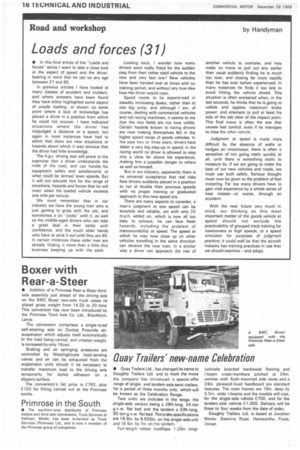Road and workshop by Handyman
Page 18

If you've noticed an error in this article please click here to report it so we can fix it.
Loads and forces (31)
• In this final article of the "Loads and forces" series I want to take a close look at the aspect of speed and the driver, bearing in mind that he can be any age between 21 and 65.
In previous articles I have looked at many classes of accident and incident, and where answers have been found they have either highlighted some aspect of unsafe loading, or shown up some point where a lack of knowledge has placed a driver in a position from which he could not recover. I have indicated situations where the driver has misjudged a distance or a speed, but again in most instances have had to admit that there are new situations or hazards about which it was obvious that the driver had little knowledge.
The h.g.v. driving test will prove to the examiner that a driver understands the rules of the road, and can handle his equipment safely and satisfactorily at what could be termed town speeds. But it will not educate him for the range of situations, hazards and forces that he will meet when his loaded vehicle exceeds one mile per minute.
We must remember that in our industry we have the young man who is just getting to grips with the job, and sometimes a bit "cocky" with it, as well as the middle-aged drivers who can take a great deal in their stride with confidence, and the much older hands who have to stick it out until they are 65. In certain instances these older men are already finding it more than a little dicy business keeping up with the pack. Looking back, I wonder how many drivers were really fitted for the sudden step from their rather staid vehicle to the new and very fast one? New vehicles have been handed over at times with no training period, and without any true idea how the driver would cope.
Speed needs to be experie:ticed in steadily increasing doses, rather than at one big jump, and although I am, of course, dealing with commercial vehicles and not racing machines, it seems to roe that the two fields are not now unlike. Certain hazards known to racing drivers are now making themselves felt in the higher speed range of goods vehicles. In the past two or three years, drivers have taken a very big step-up in speed; in the racing world no driver is allowed to step into a class far above his experience, making him a possible danger to others as well as himself.
But in our industry, apparently there is no universal acceptance that real risks face drivers suddenly placed in a position to run at double their previous speeds with no proper training or graduated approach to this new speed era.
There are many aspects to consider, a man's judgment at one speed. can be accurate and reliable, yet with only 25 m.p.h. added on, which is now all too easy to achieve, he can face fresh hazards, including the problem of manoeuvrability at speed. The speed at which he may now close up on other vehicles travelling in the same direction can deceive the new man. In a similar way a driver can approach the rear of another vehicle to overtake, and may make no move to pull out any earlier than usual suddenly finding he is much too near, and closing far more rapidly than he has ever before experienced. In many instances he finds it too late to avoid hitting the vehicle ahead. This situation is often worsened when, in the last seconds, he thinks that he is going to collide and applies maximum brake power, and attempts to pull at least his side of the cab clear of the impact point. This final move is often the one that causes lost control, even if he manages to miss the other vehicle.
Judgment at speed is made more difficult by the absence of walls or hedges on motorways; there is often a sensation of not going really quickly at all, until there is something static to measure by. If we are going to make the best of our new vehicles and roads, we must use both safely. Serious thought must now be given to the problem of fast motoring. Far too many drivers have to gain vital experience by a whole series of near misses or worse, through an accident.
With the near future very much in mind, our thinking on this most important matter of the goods vehicle at speed should not exclude the practicability of grouped track training for newcomers at high speeds, or a speed simulator for purposes of judgment practice; it could well be that the aircraft industry has training practices in use that we should examineand adopt.












































































